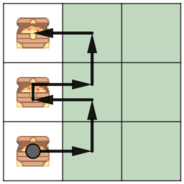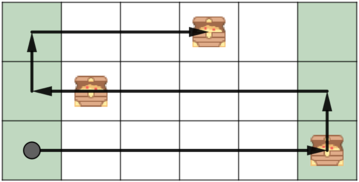codeforces_D. Treasure Hunting_[DP+Binary Search]
http://codeforces.com/contest/1201/problem/D
题意:n行m列的矩阵中,有k个targets,从[1, 1]出发,每次只能向上下左右四个方向移动一步,且只有在q个safecolumns上进行向上移动,最少需要多少次移动才能获得所有的targets。(2≤n,m,k,q≤2*10^5,q≤m)。



思路:
Make two arrays: left and right. left[i] is the treasure in the leftmost position in row i (0 if there are no treasures in row ii). right[i] is the treasure in the rightmost cell in row ii (0 if there are no treasures in row ii).
We can simply take out rows where there is no treasure (and add 1 to the result if there are treasure above that line, because we have to move up there).
For every row, except the last, we have to leave that row at one of the safe columns. Let's notice that the last treasure we collect in the row will be either left[i] or right[i]. Let's take a look at both possibilities: If we collect the left[i] treasure last, we have to leave the row either going left or going right to the closest safe column, because going further wouldn't worth it (consider moving up earlier and keep doing the same thing at row i+1). The same is true for right[i]. For the first row, we start at the first column, we can calculate the moves required to go up the second row at the for cells. For all the other rows, we have 4 possibilities, and we have to calculate how many moves it takes to reach the row i+1 at the 4 possible columns. For the last row, we don't have to reach a safe column, we just have to collect all the treasures there. We can count the answer for the problem from the calculated results from the previous row. Time complexity: O(16∗n)
1. 对于存在宝藏的行,最后得到的宝藏要么是最左边的要么是最右边的;
2. 假设最后拿到的是最左边的,那么可以通过这个宝藏左右最近的safecolumns离开;最后拿到的是最右边的情况也同理;
3. 对于第一行来说,若有宝藏,则获得最右边的宝藏后离开;所无宝藏,则通过离[1, 1]最近的safecolumn离开;
4. 对于其他行来说,最多可以有四种方式离开此行,最后一行不需要到达safecolumn,获得所有宝藏即可;
宝藏左右最近的safecolumn,可以通过binary search求得。
注意,若最左边的宝藏就在safecolumn上,则其左右最近的safecolumn都是此列。
#include <iostream>
#include <set>
#include <vector>
#include <algorithm>
#include <queue>
using namespace std; typedef long long LL; int findSafe(vector<int>& safes, int x){
int l = , r = safes.size()-, ret;
while(l <= r){
int m = (l+r)>>;
if(safes[m] == x)
return m;
if(safes[m] > x)
r = m - ;
else{
ret = m;
l = m + ;
}
}
return ret;
} int dist(int layer, int p1, int p2, vector<int>& leftmost, vector<int>& rightmost, vector<int>& safecol){
if(safecol[p1] > safecol[p2])
swap(p1, p2);
int d = safecol[p2] - safecol[p1];
if(rightmost[layer] > safecol[p2])
d += * (rightmost[layer]-safecol[p2]);
if(leftmost[layer] < safecol[p1])
d += * (safecol[p1]-leftmost[layer]);
return d;
} int main(){
int n, k, m, q;
cin>>n>>m>>k>>q;
vector<int> leftmost(n+, m+), rightmost(n+, ), safecol{};
for(int i=; i<k; i++){
int row, col;
cin>>row>>col;
leftmost[row] = min(leftmost[row], col);
rightmost[row] = max(rightmost[row], col);
}
for(int i=; i<q; i++){
int safe;
cin>>safe;
safecol.push_back(safe);
} sort(safecol.begin(), safecol.end()); while(leftmost[n] == m+) n--; if(n==){
cout<<rightmost[]-<<endl;
return ;
}
vector<LL> now_step{, , ,}, lst_step{, , , };
vector<int> lst_gate{-, -, -, -};
if(rightmost[] == ){
int rsafe = findSafe(safecol, );
if(safecol[rsafe] < )
rsafe++;
lst_gate[] = rsafe;
lst_step[] = safecol[rsafe]-;
}else{
int lsafe = findSafe(safecol, rightmost[]);
//cout<<rightmost[1]<<"*"<<lsafe<<endl;
lst_gate[] = lsafe;
lst_step[] = *rightmost[]-safecol[lsafe]-;
//cout<<"l10:"<<lst_step[0]<<endl;
if(safecol[lsafe]<rightmost[] && lsafe+ < safecol.size()){
lst_gate[] = lsafe+;
lst_step[] = safecol[lsafe+]-;
}
} for(int i=; i<n; i++){
if(leftmost[i] == m+){
for(int j=; j<; j++)
lst_step[j]++;
continue;
}else{
vector<int> now_gate{-, -, -, -};
int g1 = findSafe(safecol, leftmost[i]);
int g2 = findSafe(safecol, rightmost[i]);
//cout<<g1<<" "<<g2<<endl;
now_gate[] = g1;
if(safecol[g1] < leftmost[i] && g1+ < safecol.size())
now_gate[] = g1+;
now_gate[] = g2;
if(safecol[g2] < rightmost[i] && g2+ < safecol.size())
now_gate[] = g2+;
for(int j=; j<; j++){
now_step[j] = (*1e5+) * (*1e5);
for(int u=; u<; u++)
if(lst_gate[u]> && now_gate[j]>){
int d = +dist(i,now_gate[j], lst_gate[u], leftmost, rightmost, safecol);
//cout<<now_gate[j]<<" "<<lst_gate[u]<<endl;
//cout<<"d:"<<i<<" "<<d<<endl;
//cout<<"ld:"<<" "<<lst_step[u]<<endl;
now_step[j] = min(now_step[j], lst_step[u]+d);
}
}
lst_step = now_step;
lst_gate = now_gate;
}
}
LL ret = (*1e5+) * (*1e5);
for(int u=; u<; u++)
if(lst_gate[u] > ){
int d = +rightmost[n]-leftmost[n]+min(abs(rightmost[n]-safecol[lst_gate[u]]), abs(leftmost[n]-safecol[lst_gate[u]]));
//cout<<"d:"<<" "<<d<<endl;
//cout<<"lst_step:"<<lst_step[u]<<endl;
ret = min(ret, lst_step[u]+d);
}
printf("%I64d\n", ret);
return ;
}
codeforces_D. Treasure Hunting_[DP+Binary Search]的更多相关文章
- 96. Unique Binary Search Trees (Tree; DP)
Given n, how many structurally unique BST's (binary search trees) that store values 1...n? For examp ...
- Unique Binary Search Trees(dp)
Given n, how many structurally unique BST's (binary search trees) that store values 1...n? For examp ...
- Unique Binary Search Trees I&II——给定n有多少种BST可能、DP
Given n, how many structurally unique BST's (binary search trees) that store values 1...n? For examp ...
- [LeetCode] Unique Binary Search Trees 独一无二的二叉搜索树
Given n, how many structurally unique BST's (binary search trees) that store values 1...n? For examp ...
- [LeetCode] Unique Binary Search Trees II 独一无二的二叉搜索树之二
Given n, generate all structurally unique BST's (binary search trees) that store values 1...n. For e ...
- Leetcode 86. Unique Binary Search Trees
本题利用BST的特性来用DP求解.由于BST的性质,所以root左子树的node全部<root.而右子树的node全部>root. 左子树 = [1, j-1], root = j, 右子 ...
- Unique Binary Search Trees
Given n, how many structurally unique BST's (binary search trees) that store values 1...n? For examp ...
- LeetCode-96. Unique Binary Search Trees
Description: Given n, how many structurally unique BST's (binary search trees) that store values 1.. ...
- LeeCode - Unique Binary Search Trees
题目: Given n, how many structurally unique BST's (binary search trees) that store values 1...n? For e ...
随机推荐
- 阿里云DNS api接口 shell 更改DNS解析
可定时任务检查域名解析,调用alidns.sh更新DNS解析 #!/bin/bash # alidns.sh #https://www.cnblogs.com/elvi/p/11663910.html ...
- Nginx主要功能及使用
Nginx配置详解 序言 Nginx是lgor Sysoev为俄罗斯访问量第二的rambler.ru站点设计开发的.从2004年发布至今,凭借开源的力量,已经接近成熟与完善. Nginx功能丰富, ...
- python函数及调用
python的函数是一段重复多次可调用的代码,依据python的函数,我们可以利用函数式的编程,来减少代码的重复. 在本章节中,详细的介绍python的函数,以及python的函数式编程的与众不同,函 ...
- 基于3ds Max的游戏建模方案
前言 需求 由于本游戏的设计,需求使用到角色以及场景建模.具体模型的搭建与贴图的设计根据原画进行. 工具 一般在游戏研发中,模型的搭建主要使用以下工具和概念来渲染建模. 3ds Max 3ds Max ...
- 【Unity Shader】---基础光照
一.[标准光照模型]1.自发光emissve:描述一个表面本身会发散多少光.在没有使用全局光照时,这些自发光是不会真正照亮周围物体. 自发光就是直接由发光体发射进入摄像机,不经过任何反射,在标准光照模 ...
- Ngix 配置与部署(wsgi,uwsgi,uWSGI)
1. WSGI 是一种协议接口,他是描述web服务器如何与web应用程序(Django ,Flask ) 通讯的规范. 2. uwsgi 与WSGI协议一样,是uWSGI服务器的独占协议,用于定义传输 ...
- openstack 制作镜像以及windows向Linux中通过xshell传文件
慢慢的也要把openstack一些相关的笔记整理上来了 之前由于主要是在看horizon 实验室搭建的openstack平台并没有怎么实际的用起来,前几天别的同学要用来测试大数据的相关服务,才把这些内 ...
- [Python3 练习] 001 温度转换1
题目:温度转换 I (1) 描述 温度的刻画有两个不同体系:摄氏度 (Celsius) 和华氏度 (Fabrenheit) 请编写程序将用户输入的华氏度转换为摄氏度,或将输入的摄氏度转换为华氏度 转换 ...
- Linux快速访问多个目录
Linux下实现多个目录之间快速切换 dirs -v # 显示栈目录dirs -c # 清空栈目录 pushd # 加入当前目录pushd director # 加入指定目录pushd +/-i ...
- python 二维数组转一维数组
三种方法 比如 a = [[1, 2], [3, 4], [5, 6]] 列表推导式 [i for j in a for i in j] 库函数 from itertools import chain ...
